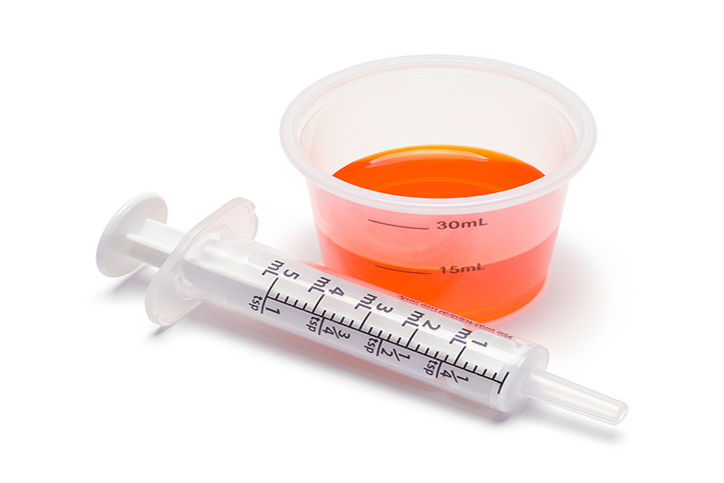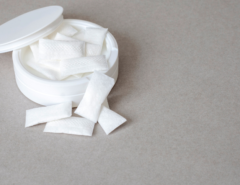Measuring medicine, also called dosing, can be confusing! Health care providers and pharmacists may use terms such as milligrams (mg), milliliters (mL), micrograms (mcg), grams (g or gm), international units (IU), or other units of measure when talking about medicine. Sometimes medicines have both mg and mL on the label, which makes things even more confusing! It is important to understand how a medicine is dosed before taking it or giving it to a loved one.
Dose Units for Solid Medicines and Creams
Medicines can come in solid forms like tablets, capsules, lozenges, and gummies. They may need to be swallowed whole, allowed to dissolve in your mouth, or chewed. Some medicines can be split, crushed, or opened (like a capsule) and put on food, while some medicines should not. Knowing how to take your medicines is very important. Be sure to talk with your pharmacist if you have questions about how to take a solid medicine.
Let’s review some commonly used dosing units for solid medicines and creams.
milligrams (mg)
Some medicines that come in a solid form are dosed in milligrams (mg). This is a measurement of weight of how much medicine is in the tablet or capsule. There are 1,000 mg in 1 gram. Keep in mind that just because a medicine has a low mg number doesn’t mean it doesn’t work as well as a medicine with higher mg numbers. It just means it takes less of it to work!
micrograms (mcg)
Some solid medicines are dosed in micrograms (mcg), which are units smaller than milligrams. There are 1,000 mcg in 1 mg and 1 million mcg in 1 gram! Remember, it doesn’t take a lot for some medicines to work, so just because a medicine is dosed in micrograms does not mean it is weak. It just means you only need that amount for it to work properly, and a higher dose could lead to more side effects.
grams (gm)
Some medicines, but not many, are dosed in grams. This includes tablets and some gels or creams. Tablets measured in grams are usually pretty large. If your gel or cream is dosed in grams, there will be a card in the box with the cream to guide you in measuring the correct amount. You can also talk to your health care provider or pharmacist if you need help with measuring out your dose.
international units (IU)
There are a few medicines that are dosed in international units (IU). Some vitamins are the most common medicines that use IU for the dose. Many vitamins also list the mg or mcg that corresponds to the IU dose. The IU is just another way to tell you how much medicine is in a dose.
Dose Units for Liquid Medicines
Liquid medicines are put into two categories – suspensions or solutions. Solutions look clear but can have a color to them. Suspensions may be thick and may have specks of medicine you can see in them. Suspensions should be shaken well before a dose is measured to be given.
Not all liquid medicines are meant for children. There are some liquid medicines that are only meant for adults to take, and others meant for children. Read the label and the packaging carefully to make sure it is safe to use for your child or talk to your health care provider.
When measuring liquid medicine, it is important to use the correct sized dropper, oral syringe, dosing cup, or dosing spoon. Only use the dosing device that comes with the medicine and has the mL listed on it.
Pay close attention to the mL dose (the amount you are supposed to use) on the label of the medicine. It is easy to read a dose of 0.8 mL as 8 mL and give 10 times the dose needed! If this happens call your local Poison Center right away at 1-800-222-1222. Do not wait for symptoms, and do not try to make the person throw up.
Liquid medicines are dosed based on the amount of medicine needed and the amount of the liquid you need to give to get that dose. Some ways a liquid may be measured are:
milliliters (mL)
A milliliter, mL, is a unit used to measure the amount of liquid, also known as volume, of medicines. It is really important to read the medicine labels carefully because there will often be mg, mcg, or IU (the weight/amount of the medicine) and mL (the amount of liquid) on the label to tell you what dose to use. The label will show the concentration of the medicine too. The concentrations tell you how many mg (or mcg or IU) of medicine are in the specified amount of liquid. For example, Children’s Tylenol has a concentration of acetaminophen of 160 mg/5 mL. This tells us that in each 5 mL of liquid there is 160 mg of acetaminophen (Tylenol). Some people will use less than 5 mL to get the right dose of medicine and some will use more!
teaspoon (tsp)
Sometimes you will hear a medicine dose is a teaspoon (tsp) or teaspoonful. A teaspoon is the same as 5 mL so if you were told to give a teaspoonful, you can use an oral syringe, medicine cup, or medicine spoon to measure the dose. Do not use household spoons to measure medicine, they will not measure the right amount.
tablespoon (tbsp)
Medicines may also be dosed in tablespoon (tbsp) or tablespoonful. There are 3 teaspoons in 1 tablespoon, so each tablespoonful has 15 mL in it. As with teaspoons you should not use household spoons, including measuring spoons, to measure out medicines.
If you do not understand how to give or take a medicine for yourself or a loved one, you should talk to your doctor, nurse, or pharmacist to make sure you understand. If you have made a medicine mistake, call the Maryland Poison Center at 1-800-222-1222, day or night. Calling is free and confidential. If the mistake was for your pet, call one of the pet poison centers at 888-426-4435 or 855-764-7661 (there is a fee for the pet poison centers).
Becka Mestas, PharmD
Certified Specialist in Poison Information





Leave a Reply